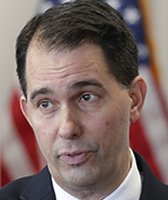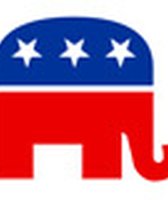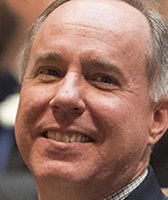Stand up for the facts!
Our only agenda is to publish the truth so you can be an informed participant in democracy.
We need your help.
I would like to contribute

A drag queen storytime event in Mobile, Ala., in 2018. (Associated Press).
No, drag shows are not the same as strip shows
If Your Time is short
-
Drag shows entail exaggerated costumes and makeup, in which the performers dance and often lip-sync to music.
-
Strip shows entail performers who remove their clothing and dance for an audience.
-
Drag shows do not typically include the removal of clothing.
In recent years, drag shows have become a target for conservatives.
For instance, drag story hours have drawn protesters and ire on conservative talk shows, and drag performers have been accused of "grooming" children to be assaulted. In Wisconsin, that rhetoric recently focused on a drag show organized by Madison East High School that was postponed because of backlash and concerns about the safety of performers and attendees.
In a Jan. 5 tweet, former Gov. Scott Walker took aim at the event, sharing a photo of the school’s January newsletter, which said the show was "family-friendly" and "meant to celebrate, affirm and support EHS students and staff in our LGBTQIA+ as well as our larger school community."
"Let’s be clear: ‘drag shows’ are strip shows," Walker tweeted. "They are wrong. They are particularly wrong at school. They are definitely not ‘family-friendly.’"
Let’s focus on the first part of Walker’s claim — that "drag shows" and "strip shows" are the same.
In short, they are not.
When we asked Walker about his tweet, he defended his position.
"In my opinion, if people take off clothing or play music or are given dollar bills by members of the audience, that is a strip show, regardless of gender," he said in an emailed statement.
But Walker is painting a distorted picture of what a drag show actually is.
According to the Merriam-Webster dictionary, drag is "entertainment in which performers caricature or challenge gender stereotypes (as by dressing in clothing that is stereotypical of another gender, by using exaggeratedly gendered mannerisms, or by combining elements of stereotypically male and female dress) and often wear elaborate or outrageous costumes."
Essentially, drag is the "art of dressing and acting exaggeratedly as another gender, usually for entertainment," according to an Oct. 22, 2022, article from PBS NewsHour. Though, as the Gay and Lesbian Alliance Against Defmation notes in its definition of "drag performance," drag shows include performers who are gay, cisgender men as well as transgender women and other gender-diverse people.
Its origins actually stretch deep into the history of theater.
"Drag is a term derived from ancient Greek theater, a Greek word meaning ‘masquerade,’ and its roots have remained in theatrical performances generally involving cross-dressing," Finn Enke, a professor of gender and women’s studies, history and LGBTQ+ studies at the University of Wisconsin-Madison, told us in a Jan. 10 email.
Cross-dressing is an ancient theater practice, from before the time of Shakespeare, with male actors often playing a variety of gender roles on stage, Enke said.
Featured Fact-check
The term drag likely stems from the fact that the dresses or petticoats worn by male actors onstage would drag across the floor, or perhaps as an acronym, used in some scripts to mean "dress as a girl," according to the NewsHour article.
Walker’s claim also hints at another argument made repeatedly by opponents of drag shows: that the performers are in a way "grooming" children.
According to the NewsHour article, the term is used to describe how child molesters entrap and sexually abuse their victims. It’s used by opponents of drag to falsely equate the shows and performers with pedophilia and other forms of child abuse.
"Perpetrators of the false rhetoric can then cast themselves as saviors of children and try to frame anyone who disagrees – a political opponent, for example – as taking the side of child abusers," the article said.
"Despite some opponents’ claims, drag cannot ‘turn’ a child gay or transgender, although its playful use of gender may be reassuring to kids who are already questioning their identity."
Now, let’s take a look at what a "strip show" is.
According to Merriam-Webster, to strip is to "take off clothes" or "to remove one’s clothes gradually piece by piece in a seductive or provocative manner especially to the accompaniment of music."
Of course, there is also music, dancing and often money given to the performers by spectators.
But drag doesn’t inherently imply nudity or the removal of clothes, according to the NewsHour story.
"Every performer makes different choices, but drag queens often wear more, not less, clothing than you’d see on a typical American woman of the 21st century, a public beach or on network TV," the article said. "Drag does not typically involve nudity or stripping, which are more common in burlesque, a separate form of entertainment."
When asked whether he had ever attended either a strip show or a drag show, Walker did not respond.
Walker claimed that "strip shows" and "drag shows" were the same type of performance.
Although both types of performance do include music and dancing, drag shows typically don’t include the central feature of strip shows: nudity or the removal of clothing.
We rate this claim False.
Our Sources
Scott Walker, Twitter, Jan. 5, 2023
Email conversation with Jim Dick, spokesperson for Scott Walker, January 10, 2023
Merriam-Webster Dictionary, "Drag," January 16, 2023
PBS NewsHour, "Analysis: Political rhetoric, false claims obscure the history of drag performance," Oct. 22, 2022
GLAAD, "Drag performance," January 24, 2023
Email conversation with UW-Madison professor Finn Enke, January 10, 2023
Merriam-Webster Dictionary, "Strips," January 16, 2023
Macmillan Dictionary, "Strip show," January 16, 2023
The Tennessean, "Drag shows have a long history in the South. Why are they drawing threats now?" Dec. 12, 2022
Browse the Truth-O-Meter
More by Laura Schulte
No, drag shows are not the same as strip shows
Support independent fact-checking.
Become a member!
In a world of wild talk and fake news, help us stand up for the facts.











































